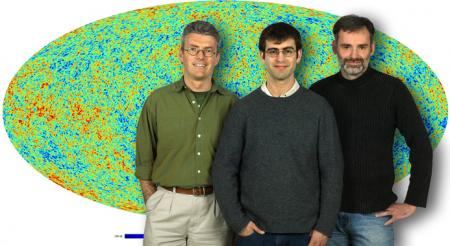Berkeley Lab Team Receives NASA Public Service Group Achievement Award
Jet Propulsion Lab honors team for computing infrastructure at NERSC
June 11, 2010
Three scientists from the Lawrence Berkeley National Laboratory’s (Berkeley Lab) Computational Cosmology Center (C3) are being honored with a NASA Public Service Group Award for developing the supercomputing infrastructure for the U.S. Planck Team’s data and analysis operations at the Department of Energy's National Energy Research Scientific Computing Center (NERSC).
The award will be presented to current C3 members Julian Borrill, Christopher Cantalupo and Theodore Kisner, as well as former members Sara Ricciardi, Federico Stivoli and Radek Stomporon on June 15, 2010 at the Jet Propulsion Laboratory in Pasadena, Calif. All three researchers are also members of the U.S. Planck Team. The NASA Public Service Group Achievement Award honors a group's outstanding accomplishment that has contributed substantially to a NASA mission.

U.S. Plank team members Jullian Borrill, Christopher Cantalupo and Theodore Kisner stand in front a map of cosmic background radiation created by the Plank infrared telescope. (Photo by Roy Kaltschmidt)
The European Space Agency's Planck satellite— in which NASA is a major partner— is currently gathering the most detailed observations ever made of the Cosmic Microwave Background (CMB), which is essentially the leftover light from the Big Bang that permeates our universe. Transforming these observations into maps of the CMB is a very significant computational challenge in which NERSC’s supercomputers play a leading role. Computing is so critical to the U.S. contribution to the mission that NASA and DOE have entered into a unique Interagency Implementation Agreement guaranteeing Planck long-term access to NERSC resources.
"The CMB is our most valuable resource for understanding fundamental physics and the origins of the universe. We have spent much of the last decade getting the Planck data analysis infrastructure set up at NERSC, and getting this award is really a great honor to our work," says Borrill.
In addition to developing and maintaining the massively parallel software for processing and analyzing data collected by the Planck's high- and low-frequency instruments, the C3 scientists also work closely with NERSC staff to ensure that both the data and the mission-specific and general CMB analysis tools are available on all of the facility's platforms and accessible to all members of the U.S. Planck Team.
The Berkeley Lab team is also named on a second award to the US Planck Data Analysis team for outstanding participation as a partner with Euopean colleagues in conceiving and implementing the overall data analysis strategy for the Planck mission.
For more information about Berkeley's legacy of computational cosmology, please read:
NERSC Continues Tradition of Cosmic Microwave Background Data Analysis with the Planck Cluster
Mapping the Universe to the Beginning of Time
C3 is a joint center of the Berkeley Lab's Computational Research and Physics Divisions.
About Berkeley Lab
Founded in 1931 on the belief that the biggest scientific challenges are best addressed by teams, Lawrence Berkeley National Laboratory and its scientists have been recognized with 16 Nobel Prizes. Today, Berkeley Lab researchers develop sustainable energy and environmental solutions, create useful new materials, advance the frontiers of computing, and probe the mysteries of life, matter, and the universe. Scientists from around the world rely on the Lab’s facilities for their own discovery science. Berkeley Lab is a multiprogram national laboratory, managed by the University of California for the U.S. Department of Energy’s Office of Science.
DOE’s Office of Science is the single largest supporter of basic research in the physical sciences in the United States, and is working to address some of the most pressing challenges of our time. For more information, please visit energy.gov/science.










